A guitar capo is a device that clamps onto the guitar neck and reduces the length of the strings that may be played. It’s important for guitar player to learn how to use capo on guitar, as it enables guitarists to modify the pitch of their instrument without having to re-tune the strings.
Capos are often utilized in a variety of music genres to make particular chords easier to play, to create unusual sounds, or to change the key of a song to accommodate a singer’s vocal range. One of the best things about them is that they don’t require extensive guitar lessons to learn how to use.
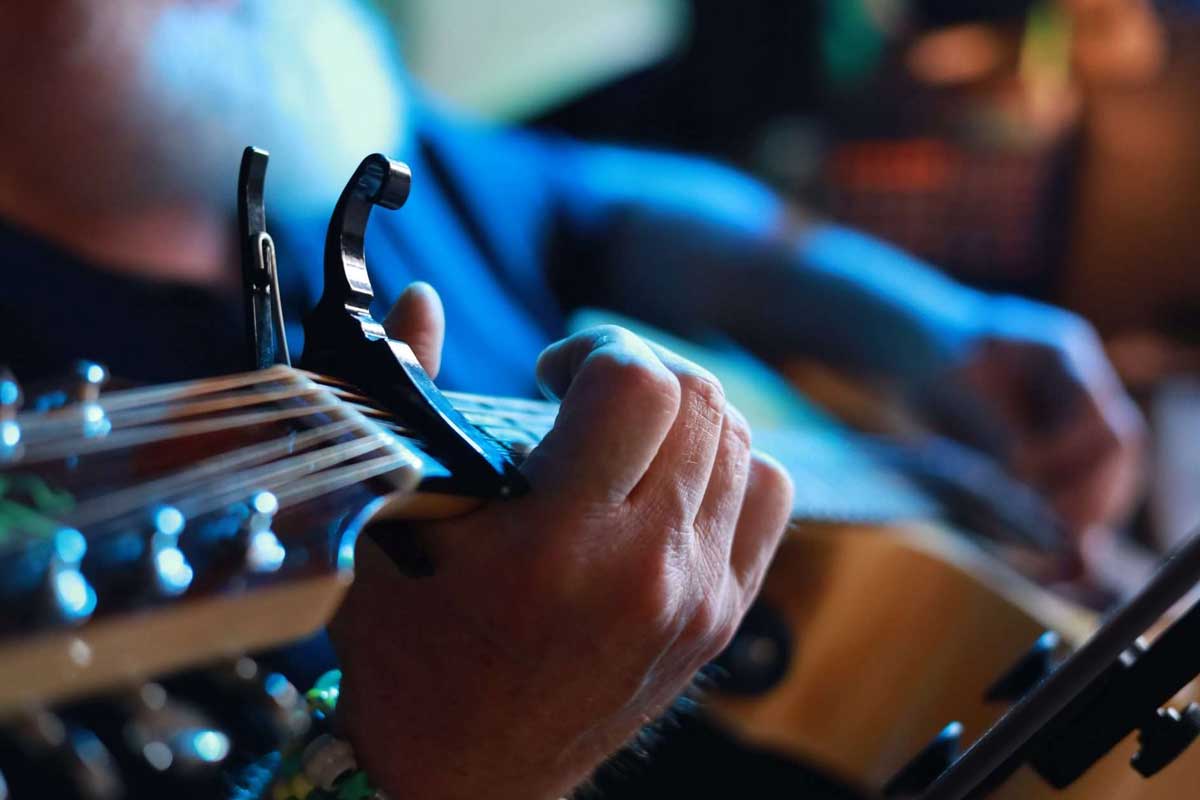
Benefits of Using A Capo
A capo can allow the key of a song to change in order to fit the singers vocal range better, it can offer instant alternate tunings, & help to play unique progressions & voicings.
They can also can also make learning easier for a guitar player, and they offer great variety and depth. In this article, we will discuss in detail how you can use a capo on the guitar.
What Music Genres Are Capos Usually Used In
Capos are commonly found in genres such as folk, country, bluegrass but also to change keys in genres such a rock & even for use in a pop song.
They are typically used in acoustic guitar playing but less commonly, can also be used by a lead guitarist in a rock band for example.

What is a Capo and how does it work?
A capo is a handy tool that guitar players use to change the sound of their guitar. To use a capo, you just need to clamp it onto the guitar’s fretboard in order to play in different keys.
The capo is spring loaded & works like a clamp, so you can easily squeeze it & place it where you need it on the fretboard.
Once the capo is in place, it will press all the strings down and you will now being in a different key ready to play your favorite songs.
Related: How to play the B minor guitar chord
How to use the Capo?
The capo has a tightening or clamping mechanism, and while there are different types of capos such as the toggle capo, c clamp capo, and trigger capo, they all have the same function.
Some capos come with a bar that clamps on the guitar strings. The bar is held in place by a screw or a cam-style clamp, that will enable you to tighten the bar.
In addition, to cloth and toggle, and bar mechanism capos, there are also partial capos. The partial capo works like a normal capo, but instead of completely covering the six strings, it only covers them partially.
For instance, you can use the partial capo to cover all the strings except for the low e string. Partial capos are typically used as a substitute for alternative tunings.
However, partial capos are complex, so we recommended sticking to those capo designs that cover all six strings.

Are There Different Types of Capos?
There are several different styles of capo but they essentially they all do the same thing, which is clamp down on the strings as if you were fretting a barre chord.
Here’s a few commonly found capo types:
Spring-loaded These are the most common type of capo, which are spring-loaded . These are perhaps the best capo for a beginner since they are simple to use.
Strap/toggle: These are basically just a strap that wraps around the fretboard. They often use a lever that allows them to be toggled on or off.
Partial: These cover only some of the strings, allowing guitarists to create original chords, shapes, and tunings.
Sliding: This type can be rolled up and down the fret board, allowing for precise adjustments to the pitch of the guitar.
Spider: These use a series of adjustable arms to clamp onto individual strings, allowing for unique tuning options.
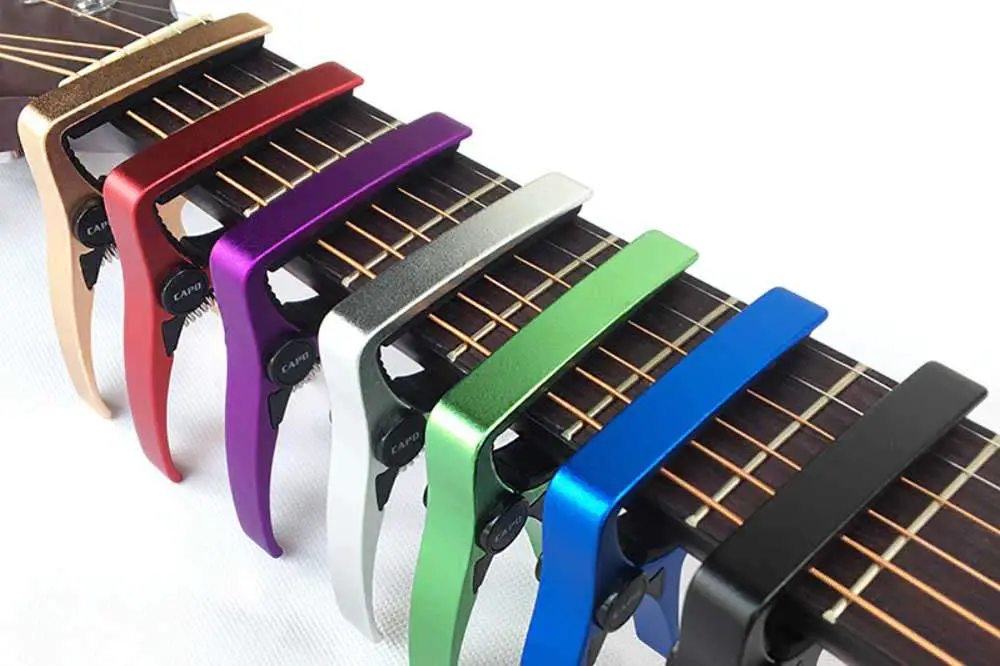
How To Use Capo On Guitar
While many people think that you can only place the Capo on an acoustic guitar, you can also put it on electric guitars. To use a spring loaded capo (which is most common),simply squeeze it & place it on the first fret, second fret, or third fret for example.
Clamping it down will effectively shorten the playable length of the strings & change the original key to something new.
However, be aware of using the capo properly & don’t overtighten if using something other than a spring loaded version. as this can damage the electric guitar.
Once the capo is placed on the desired fret, you can begin playing the guitar with your new key.
Capo can help you change the keys of a song
If you are aware of a progression and want to change things up, to better suit a vocal range or for a different sound, a Capo can help you achieve this.
You don’t need to learn to play the guitar differently, you can just apply your Capo, to develop a brighter sound
If you are decreasing your fretboard length, you are making the guitar tone brighter and higher.
Things you play on the guitar will have more of a shine, as higher frequencies will ring out of the guitar.
This process is typically known as voicing the guitar, and a chord will have a different voicing when the capo is on a higher fret, than one that is played without a capo and near the nut.

Other uses of the Guitar Capo?
Capos can do more than just change your tuning to play a particular song. There are other reasons you can use a capo for:
Simplifying chord progressions: Capos can be used to simplify progressions by allowing guitarists to play chords that are normally difficult to finger or transition between in certain keys.
Creating unique sounds: Capos can be used to create unique sounds and tonalities by changing the pitch and resonance of the guitar.
Accommodating different vocal ranges: A capo can also be used to adjust the key of a song to fit the vocal range of a singer, making it easier to sing along with a particular melody.
Exploring alternate tunings: Finally, a capo can be used in conjunction with alternate tunings to create a wider range of tonal possibilities and to experiment with different voicings.
Overall, a capo is a versatile tool that can be used in a variety of musical contexts to expand a guitarist’s playing options, creativity, or make songs easier.
What is a Guitar Capo Chord Chart?
The tuning of a guitar changes based on where you have positioned the capo on the instrument.
This means that if you learn an easy progressions, and play the chord on the third fret with a capo, the chords sound good.
It can take a guitar player a while to figure out the capo chart, so let’s walk through it together. If you observe the first row in the chart, you will see the word ‘Open Chord Shape’.
On the right side of the guitar capo chart, you will see a 7 columns. If you play a C chord in position zero, the chord will be C. This is the C chord most guitar players love.
If you were playing a C shape & applied the capo to the second fret, you would now be playing a D chord with a C chord shape.
Your fretting hand is holding a shape you perceive as C, but since the capo is placed on the 2nd fret, the guitar key is raised. Now the C shape has become D. If you go two frets higher to the 4th fret, you will be playing on E.
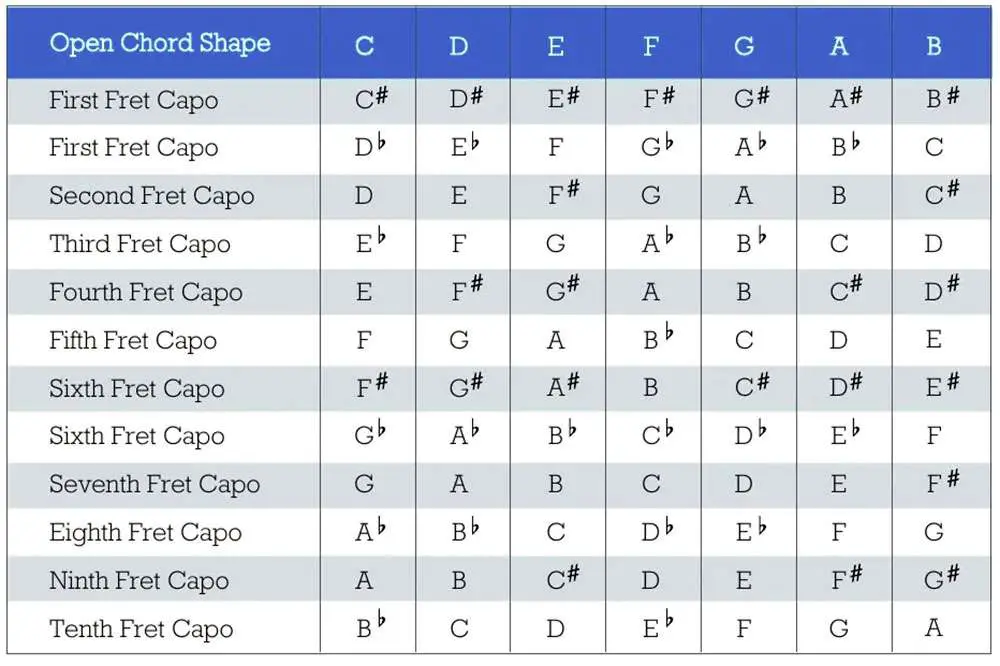
Barre Chords
A barre chord is a sort of chord that is played on the guitar by using your index finger to hold down numerous strings, forming a “bar” across the fretboard.
Barre chords are often utilized in many types of music, including rock, blues, and pop, and can be shifted up and down the neck to form new chords.
How A Capo Effects A Chord Progression
A capo alters the pitch of the guitar without affecting the fingerings of the chords, allowing a song to be transposed into a different key.
This can produce a different tonality and make it easier to play certain progressions that would be more difficult in the original key.
What is the movability of the chord?
All the chord shapes have movability, this includes D, C, E, and A chords.
When making bar chords, guitar players are moving around the A and E open chord shape. However, making chords by barring behind them is difficult, so this is where a capo be helpful for you.
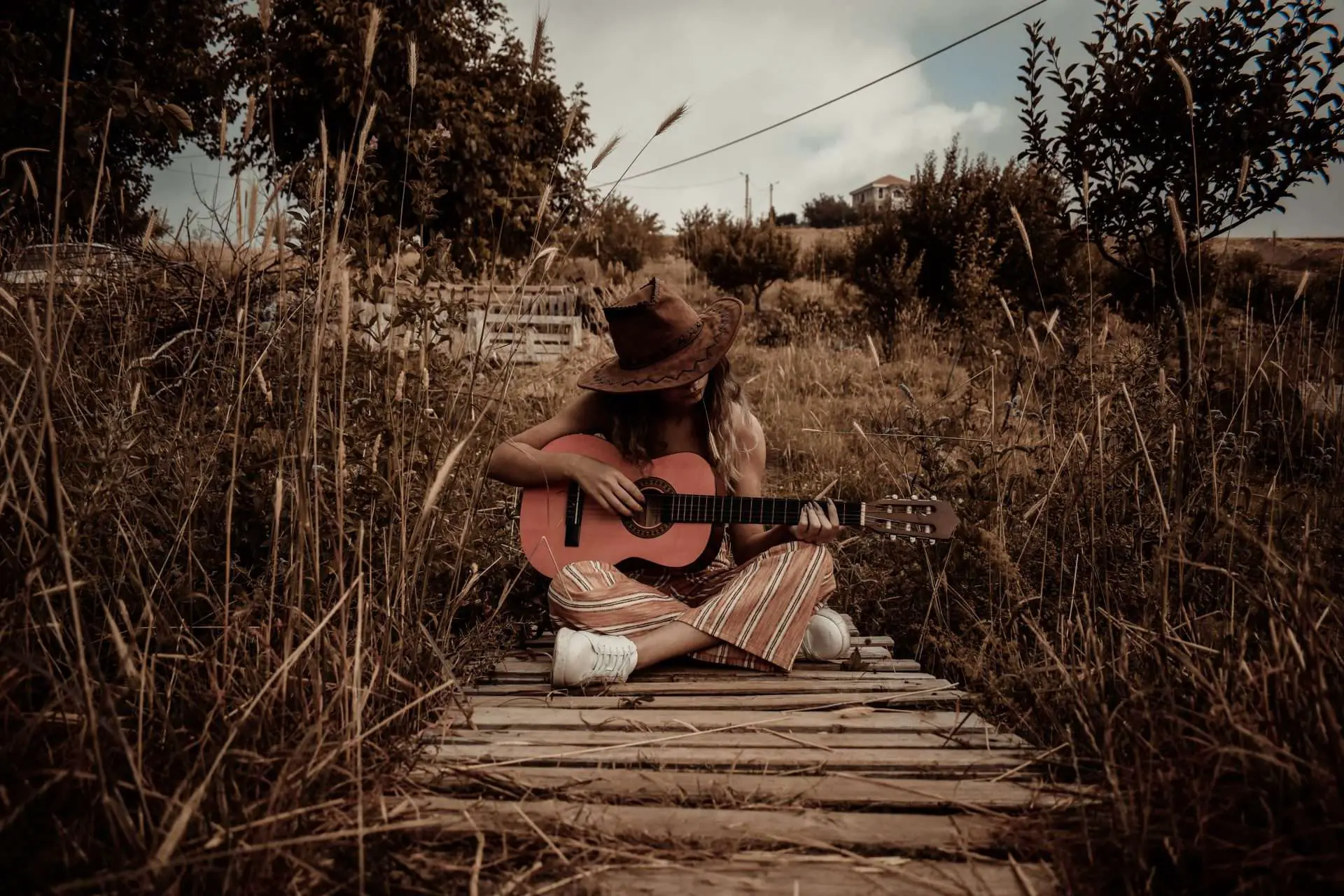
Should Beginners use a Guitar Capo?
Many guitarists, including beginners, use capos when playing the guitar. They do this because it makes some melodies, chords, or songs easier to play.
That said, there are a few things beginners should remember before they learn how to use capo on guitar. The capo shortens the guitar neck, which can make fretting chords and notes up the neck more difficult if dexterity isn’t developed enough. You have to be fast at moving it around.
You might also need to adjust your tuning accordingly when you take off or put on the capo on the guitar. Since the capo raises the key you are in, you also have to be mindful of music theory to get the most out of it.
If you take regular guitar lessons, you can ask your guitar teacher for tips on how to use & exercise using a capo.
When Should A Capo NOT Be Used
A capo should not be used if it could damage the guitar or the strings, such as when the strings are old or brittle.
Furthermore, using a capo may be inappropriate if it results in chord voicing that does not fit the musical context or if it is not required to achieve the desired sound or playing style.
Therefore, the decision to utilize a capo should be based on the necessities of the specific musical arrangement as well as the guitarist’s tastes.
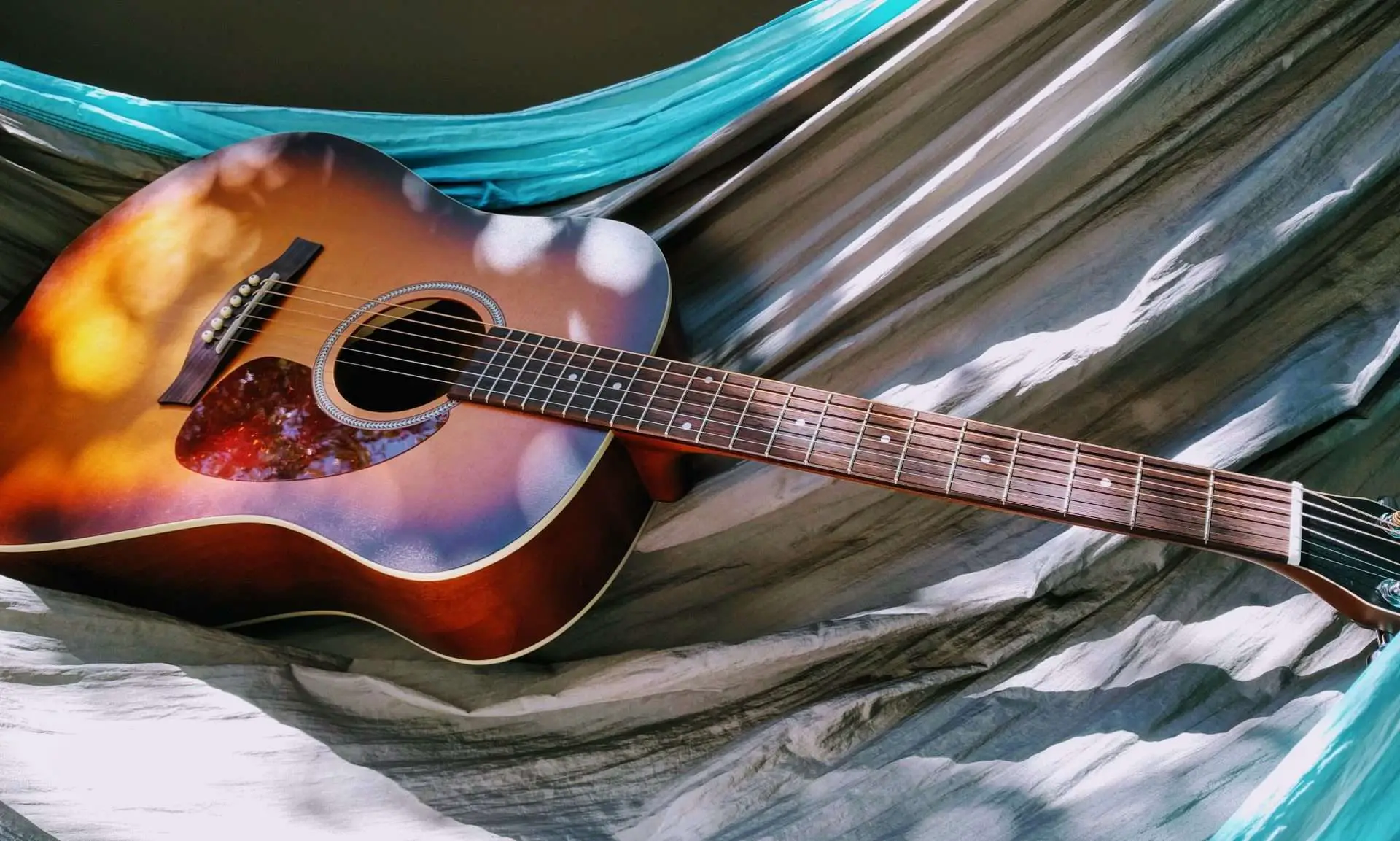
Conclusion
The primary advantage of utilizing a guitar capo is that it allows guitarists to play in multiple keys while maintaining the same chord patterns without having to re-tune the strings.
This makes certain progressions and melodies easier to play and offers up new possibilities for chord voicings and playing styles.
A capo is commonly employed in a variety of music genres, including folk, country, and pop. Capos are utilized in folk and country music to create a brighter, more open sound, yet in pop music, capos can be used to play songs in higher keys to better fit a singer’s vocal range.
